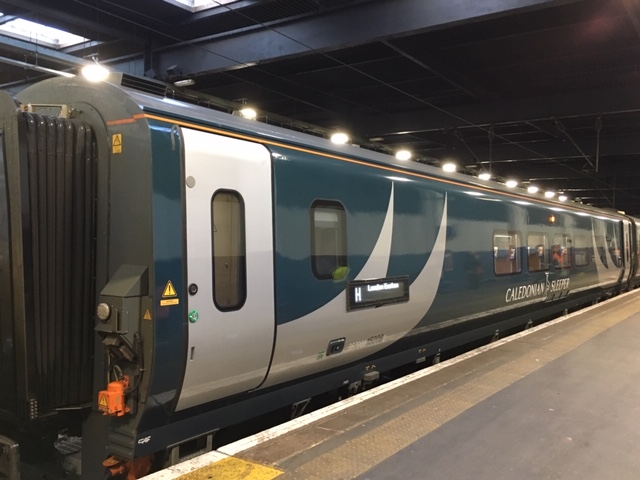LONDON — The Caledonian Sleeper train which will offer service between Scotland and London has made its first trial run to London, preparing for service set to launch in May.
The train features the first new sleeping car equipment in the United Kingdom in 35 years [see “New Scotland Sleepers debut,” “Passenger,” December 2018 Trains]. Sixteen cars made the test trip from Scotland to London Euston station.
“Caledonian Sleeper will undergo a huge transformation in 2019 and we are now entering the final stages of our testing and approvals program,” Ryan Flaherty, managing director at Caladonian Sleeper for Scottish franchise operator Serco, said in a press release. “Bringing our new carriages into London Euston for the first time is an exciting landmark for the team, and we cannot wait until they are arriving and departing from the station six nights a week.”
The fleet, built at a cost of over 100 million British pounds (approximately $130 million, including $100 in government grants), will feature standard and accessible cars with a variety of sleeping accommodations
— Updated Jan. 22 at 2:55 p.m. to clarify test run was the first to London.















This is replacement equipment for the existing sleeper train. Note the wording “Caledonian Sleeper will undergo a huge transformation in 2019 and we are now entering the final stages of our testing and approvals program…”
If the Caledonian Sleeper succeeds, the all-private room sleeping car trains could return globally. This is something for Brightline to consider when they expand beyond Florida. In the 1920’s, L&N’s then premiere train, “The Pan American” had dedicated Pullman sleepers between New Orleans, Mobile, Montgomery and Birmingham, respectively, to allow passengers a full night of sleep.
The “Lowland Sleeper” as the Edinburgh & Glasgow is know by only stops in 4 places from Edinburgh and only 5 places from Glasgow to London. Basically it is carrying people from the major cities. Check out www. caledoniansleeper
Charles Landey mentions York and Durham. Since Euston is the London terminus it likely is using the West Coast main line and wouldn’t pass through those places (served from Kings Cross). The article here does not indicate what stations it is planned to serve in Scotland.
And as to running it slower to provide enough time for a night’s sleep, that would make it easier to blend in with freight traffic. That’s a win-win for both the operating folks and the customers. Alternatively, some cars might be dropped in Glasgow to be occupied for another few hours while the rest of the train heads further north.
Charles Mortenson – Good question I looked up the schedule. London to Edinburgh is only to either side of 5 hours (I would have thought more time elapsed, even at 125 mph max). Trains would have to slow down overnight for the Edinburgh schedule to make any sense for sleeping car passengers. Intermediate cities like York or Durham (both in England) would make even less sense for a sleeping compartment.
Bear in mind, Charles, the article actually doesn’t say where the train is going. Edinburgh is the closest Scots city to London (and the major traffic generator). Glasgow is further west. Northern Scotland gets a lot further north at a lot slower speed. London to Perth (Scotland) definitely is sleeping car territory.
To any advocate of rail transportation, this is exciting. Looking at the cost of equipment, though, is rather frightening. It would be hard enough to make rail transit economically sensible even if the equipment would cost a whole lot less.
Is the trip from London to Edinburgh or Glasgow long enough for a decent night’s sleep?
Glad the government threw in a hundred bucks. Can’t say they never pick up a check.